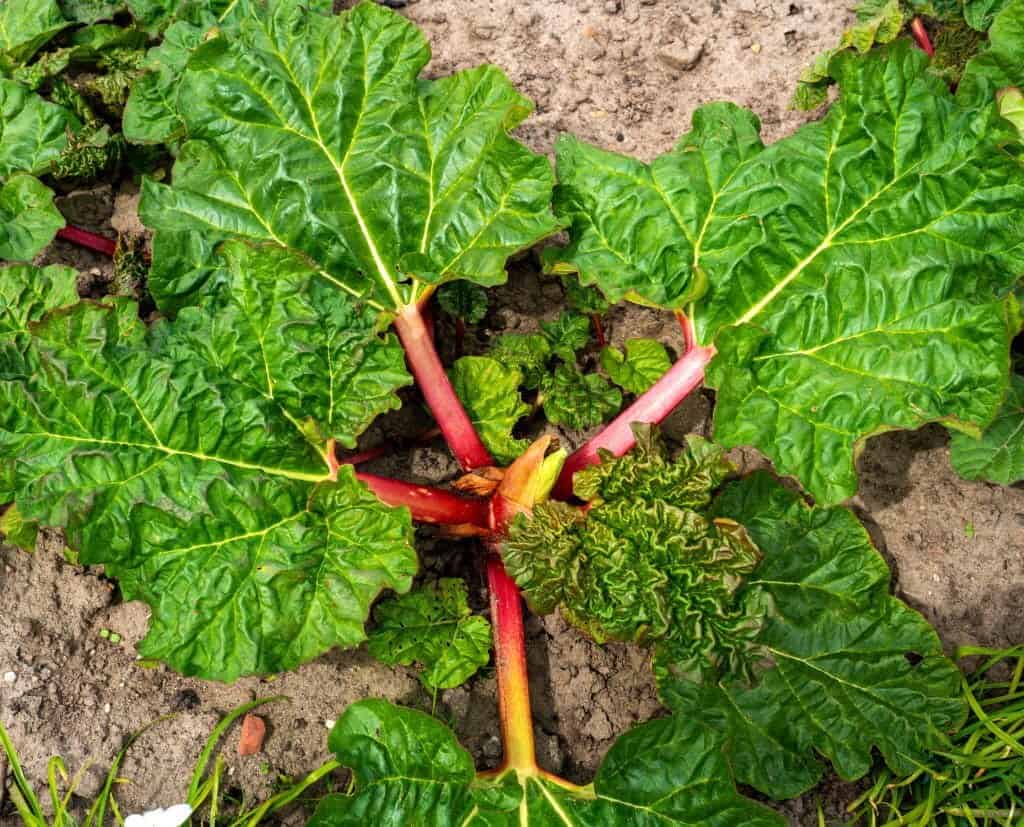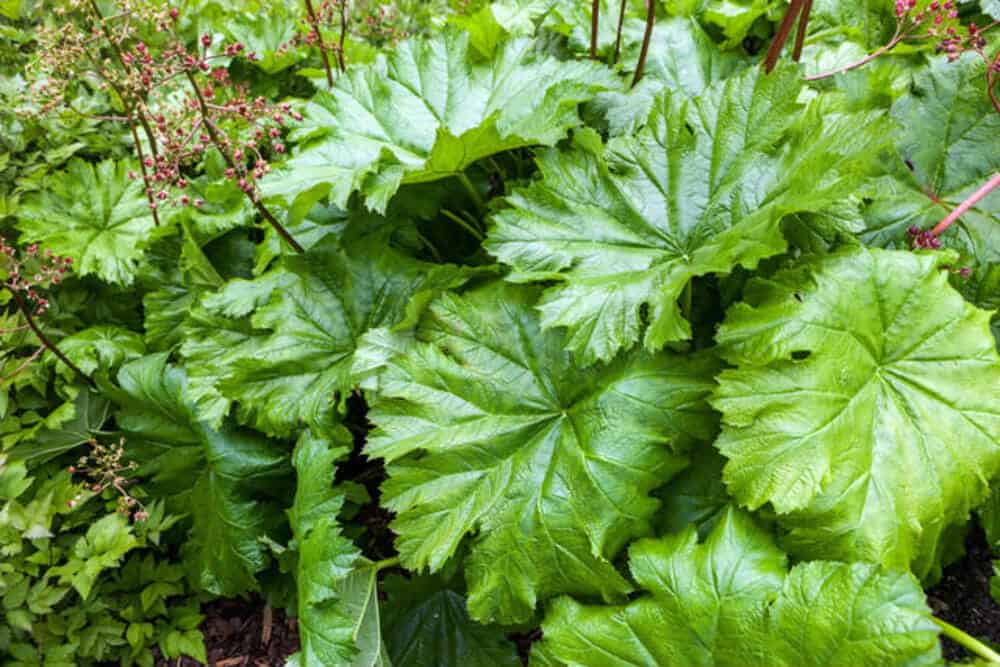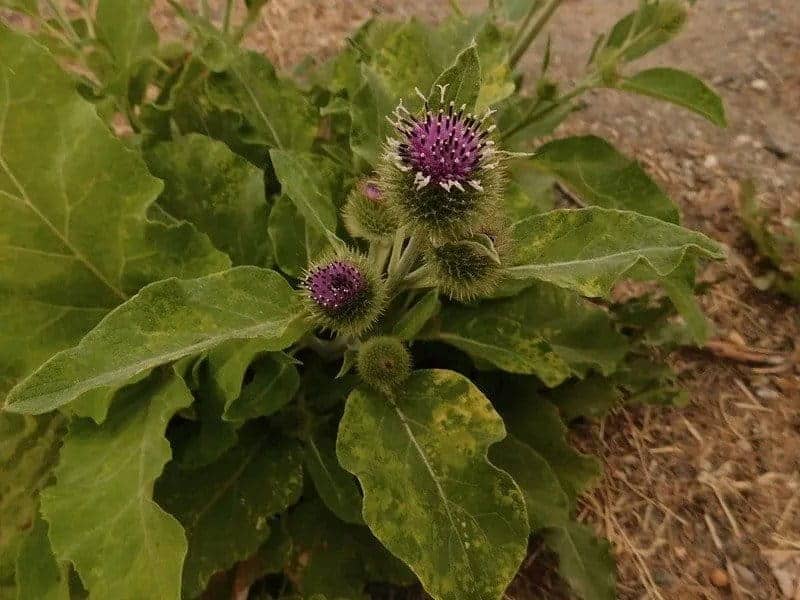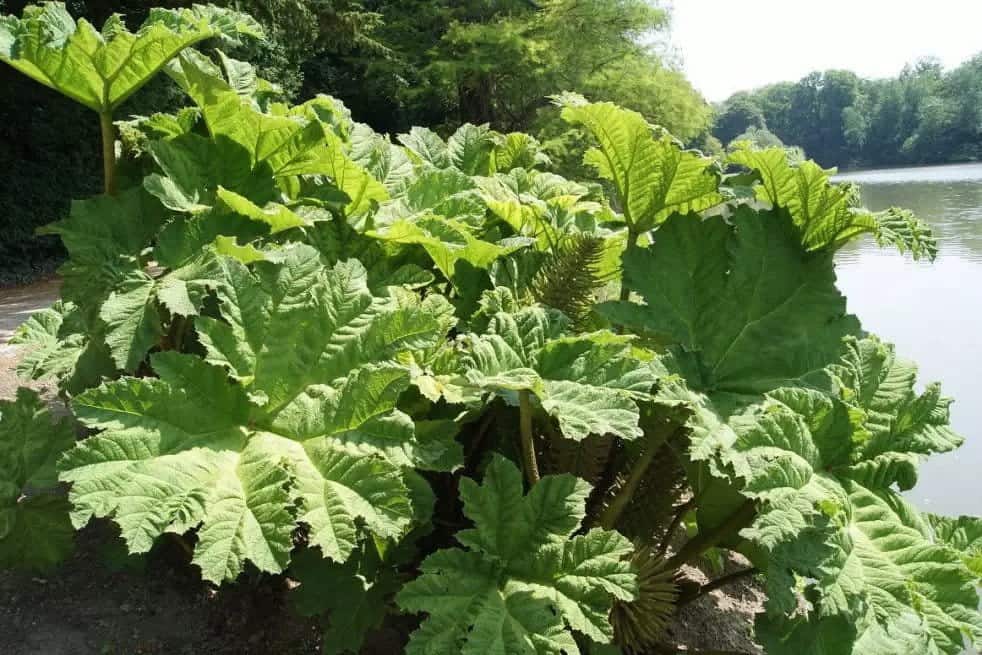Have you ever seen weeds that look like rhubarb?
Rhubarb is the fleshy, edible stalks (petioles) of Rheum species and hybrids (culinary rhubarb) in the Polygonaceae family, which are cooked and eaten. This plant is a herbaceous perennial with short, thick rhizomes.
The large, triangular leaves are inedible due to high levels of oxalic acid and anthrone glycosides. The small flowers are arranged in large compound leafy inflorescences ranging from greenish-white to rose-red.
Furthermore, rhubarb is a spring vegetable, one of the few that remains truly seasonal. The vibrant pink stalk of this perennial plant is edible.
This plant, in addition to being used to make nutritious dishes, is also used to make a variety of tonics. However, this plant is closely related to a number of other wild plants. So keep reading to learn how to tell them apart.

What does rhubarb look like?
Rhubarb is a herbaceous perennial found in Rheum species and hybrids; it is also a member of the Polygonaceae family.
It spreads by means of short, thick rhizomes. Rhubarb’s fleshy and edible stalks are a fantastic culinary addition, according to gardeners.
This is common in the United States and Europe. However, in Asia, it is primarily used for medicinal purposes. Because of the high levels of oxalic acid and other compounds such as throne glycosides in their large triangular leaves, they are inedible.
Rhubarb flowers are tiny and form large leafy rose-red or greenish-white inflorescences. Gardeners consider the plant to be primarily a vegetable, but it also serves the culinary use of fruit.
Their stalks come in a variety of colors, with the most common being red or pink. Rhubarb has a sour flavor, and most gardeners prepare it with other ingredients such as sugar and use it in desserts.
Rhubarb grows best in cooler temperatures that are less than 5 degrees Celsius. When fast growth is stimulated in the spring, it emerges from dormancy. It thrives in summer temperatures of less than 23 degrees Celsius, which promotes vegetative growth.
Weeds that look like rhubarb?
Many weeds that resemble rhubarb have toxic effects on human health if consumed or touched by their toxic leaves. Here are a few that we cover.
1. Indian Rhubarb

In Europe and America, the plant is known by various names. They thrive in cool temperate climates. It has long, slender reddish stems with a stiff leaf stem. The leaves are oval to nearly circular in shape, with sharp edges. They are 2-4 cm wide, similar to rhubarb leaves but smaller. The flowers are either white or red-purple in color.
The perennial herb Indian Rhubarb grows to a height of 12 cm. It has a deep taproot and reddish-purple flowers at the top of its rough stems. The leaves are ovate in shape, dark green in color, and have a smooth, shiny surface.
The leaves are round or slightly oval in shape and can grow to be 60 centimeters long. The texture of the leaves is thick, fleshy, and moist. The plant’s stem is quite long, flexible, and stout. It has bristly hairs that are red, pink, or purple in color.
2. Swiss Chard

Swiss chard is a rhubarb-looking plant with big leaves. This plant, like rhubarb, can be eaten.
It should be noted, however, that it may alter the flavor of the food. Unlike rhubarb, which has a sour flavor, rhubarb is less bitter, particularly when cooked.
Swiss chard is easy to spot in your yard, despite having very identical leaf features. The plant has a fuzzy appearance in humid environments, unlike rhubarb plants.
In addition, the stem is white instead of the customary green or red. The two plants, however, grow to virtually identical heights.
You can leave Swiss chard to grow alongside other plants because it is not toxic when consumed.
3. Bog Rhubarb (Petasites japonicus)

Butterbur, Great Butterbur, Blatterdock, Bogshoms, and Sweet Coltsfoot are some of the other names for Bog Rhubarb. It belongs to the Asteraceae family and is a perennial plant.
Korea, Japan, Sakhalin, and China are among the Asian countries where they can be found. Their rootstocks are thick and meaty, and they like to creep.
They have a peculiar characteristic of blooming before the leaves appear. Their flowerheads appear as capped clusters with a dense spike, with many bracts interlaced on a spherical, thick flower stalk.
The flower stalks are purplish in color and first appear in late winter or early spring. Bog Rhubarb leaves were once utilized as rain caps or butter wrapping material.
4. Japanese Knotweed (Reynoutria Japonica)

Fallopia japonica (Japanese knotweed) is a perennial herbaceous plant that is endemic to East Asia. In other regions of the world, like Europe and North America, it is sometimes regarded as an invasive weed.
When it’s young, Japanese knotweed looks a lot like edible rhubarb. Rather than the smooth leaves of the actual rhubarb plant, it has wiry hairs covering its stems. Its leaves have deeply split lobes at the same time.
Even folk healers sometimes thought of Japanese knotweed as an edible herb. Soft and sweet, with a mild flavor, it is said to be. Cooked shoots can be eaten raw, frozen, or substituted for other vegetables in soups and stews.
5. Burdock weed (Arctium Asteraceae)

The “wild rhubarb” is the common name for burdock weed. It was given this name because it has enormous leaves that are similar to those of the edible plant.
It also has a rhubarb-like crimson stem. Because of these two characteristics, the weed is one of the most similar plants to the tasty vegetable.
Burdock weed, on the other hand, is not edible. You may have a mild to severe reaction if you accidentally cook it or use it in cuisine.
When preparing the stem for eating, you may observe that it is hollow, although it is easy to miss such details.
So, how can you distinguish between rhubarb and burdock? The weed does not produce red and white flowers like rhubarb. Burdock weed has thorny burrs on the top instead of blooms.
6. Brazilian Giant Rhubarb (Giant Rhubarb)

Brazilian rhubarb is a rhubarb-looking blooming plant. The plant is known as gigantic rhubarb because of its massive leaves.
The weed, on the other hand, is exceedingly hazardous, unlike the food plants in your yard.
The Brazilian rhubarb is simple to recognize, thanks to its massive leaves and rapid growth. The weed, for example, has rusty red leaves that are distinct from rhubarb. The stem is also tall and green.
The weed thrives in a variety of soil types and textures. The weed can be toxic if gathered and eaten incorrectly.
How to limit the growth of weeds in the garden
Wild Rhubarb, also known as Common Burdock, is an invasive species that can be grown in your garden because it requires minimal maintenance. It is a low-maintenance plant that requires little care.
Wild Rhubarb infiltrates your garden by every means possible, establishing weed plants amid the actual rhubarb.
As a result, make careful to identify and remove them as soon as possible by following the measures outlined below.
- Using pruning shears, remove the rhubarb stalks and leaves.
- With a trowel, dig out the base of rhubarb stalks and discard the stalk.
- Now dig a four-foot radius around the rhubarb plant to remove all exposed roots. You won’t be able to remove all of the roots, but the more you remove, the more effective it will be.
- Make the solution by mixing any lawn weed killer and following the manufacturer’s directions. It is certain to kill rhubarb. Spraying rhubarb weeds with any broadleaf weed killer with Dimethylamine salt is effective.
- Spray the weed killer solution on the four-foot area where the rhubarb was found. Allow some time for the chemicals to take effect by leaving the area undisturbed. For the following 24 hours, avoid using sprinklers or watering.
- If rhubarb sprouts appear, pull them out and reapply the weed killer if more sprouts appear.
Final thoughts
Above are ways to distinguish the type of tree-shaped like rhubarb. Please distinguish carefully and take measures to eliminate weeds.